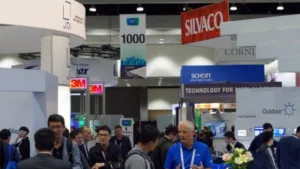
I’ve been in the US this week for the SID Display Week. Thanks to the team for getting the issues done even though we were strained because of time differences!
As I was keen to tell people at the event, this was my 24th consecutive SID show. As I discovered last year, when I went back to review my very first report, the companies that I wrote about were all American, European or Japanese. That wasn’t the case this year, and Tianma and BOE of China both showed some very impressive technology. China was also the big topic at the Business Conference, as the huge boost in capacity coming in the industry over the next few years will be almost all in that country.
However, other companies also showed a lot of good things, and I thought AUO and JDI both had impressive technology on their booths. We’ll have details next week, but there were a lot of fantastic small displays. In fact, on reflection, most of the really exciting samples and demonstrations were in the small and medium size segment. Of course, there were plenty of good looking TVs, but not much that we hadn’t already seen at CES or ISE.
One item caught my eye, which was an autostereoscopic display from Dimenco, now owned by the Chinese. We’ll have full details in the report and I didn’t spend a lot of time with it personally as I wasn’t the nominated reporter for the company. However, to me it reflected an inflection point. 22 years ago, I made a visit to Philips Research in the UK when Philips and saw my very first autostereo monitor, shown by Philips Research at an SID UK Chapter meeting in the UK in February 1996. A CRT was being used for the demo, I think, but it might have been a very early LCD. By the time Cees van Berkel spoke at a conference in Paris in 2009, he was talking about high resolution LCDs (anybody remember the IBM ‘Bertha’ which was a 22″ with 3840 x 2400 resolution that was commercialised in 2001?)
Anyway, you always needed a leap of imagination to think how good glasses-free 3D would look if you had all the pixels that you need. There were always artefacts from the display as you moved between views. However, the display at SID, which used an UltraHD panel and a liquid-crystal based lenticular lens system to allow switching between 2D and 3D, looked really good and that is, I think, the first time I have said that about the technology (which was spun out of Philips as Dimenco, before the Chinese takeover).
I think that’s probably an inflection point. I could see a notebook with this kind of autostereo 3D display being very popular on a gaming notebook. That’s assuming that the price wasn’t too much and there wasn’t too much loss of optical efficiency caused by the lenticular lenses. I only spent two minutes with Dimenco as I tried to finish my work on the show floor so I’m looking forward to the details that should come through from our team and will be in our full report that we will be working on for the next week or so.
Bob


